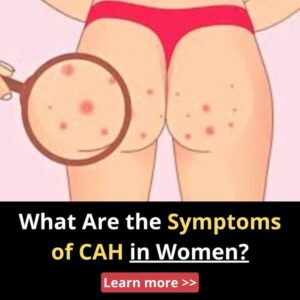
What Causes CAH?
CAH is caused by mutations in genes that code for enzymes responsible for adrenal hormone production. The most common form—accounting for over 90% of cases—is due to a deficiency in the enzyme 21-hydroxylase.
This deficiency leads to low levels of:
-
Cortisol, which regulates stress response, blood sugar, and metabolism
-
Aldosterone, which helps maintain salt and water balance
Meanwhile, the body often produces too much androgen (male sex hormones), which can lead to unusual physical development.
CAH is inherited in an autosomal recessive pattern, meaning both parents must carry the faulty gene for a child to inherit the condition.
Types of CAH
Classic CAH
This is the more severe form and is usually diagnosed in infancy. It includes:
-
Salt-wasting CAH: The body loses too much salt, leading to dehydration, low blood pressure, and even life-threatening crises if untreated.
-
Simple virilizing CAH: Salt loss isn’t as severe, but androgen overproduction still causes abnormal genital development and early puberty.
Non-Classic CAH
This milder form typically shows up later in childhood or even adulthood. Symptoms may include:
-
Irregular menstrual periods
-
Excess facial or body hair
-
Severe acne
-
Fertility problems
Some people with non-classic CAH may remain undiagnosed for years due to milder symptoms.
Signs and Symptoms
Symptoms vary depending on the type and severity of CAH. Common signs include:
In Infants
-
Poor feeding and weight gain
-
Vomiting and dehydration
-
Abnormal genital development in females (ambiguous genitalia)
-
Lethargy or poor response
In Children and Teens
-
Early onset of puberty
-
Rapid growth in childhood but short stature in adulthood
-
Severe acne or oily skin
-
Irregular periods or absence of menstruation (females)
-
Deep voice or increased muscle mass (females)
In Adults
-
Fertility challenges
-
Hormonal imbalances
-
Persistent acne or hirsutism (excess hair)
How Is CAH Diagnosed?
Many countries screen for CAH at birth, using a blood test to measure 17-hydroxyprogesterone (17-OHP) levels—a precursor that builds up when 21-hydroxylase is missing.
Other diagnostic steps include:
-
Hormone level tests
-
Genetic testing to confirm mutations
-
Adrenal imaging (in some cases)
-
ACTH stimulation test to assess adrenal function
Early diagnosis is crucial to preventing complications and supporting normal development.
Treatment Options
There is no cure for CAH, but it can be effectively managed with medication and ongoing care.
Hormone Replacement Therapy
The main goal is to replace missing hormones and suppress excess androgen production:
-
Hydrocortisone, prednisone, or dexamethasone to replace cortisol
-
Fludrocortisone to replace aldosterone (especially in salt-wasting CAH)
-
Salt supplements in infants and young children
Surgery
In some cases, reconstructive surgery may be considered for females with ambiguous genitalia. This is a sensitive topic and should involve shared decision-making with specialists and parents.
Monitoring and Follow-Up
Patients with CAH require:
-
Regular blood tests to adjust hormone dosages
-
Growth monitoring in children
-
Bone density checks in adults
-
Stress-dose steroids during illness or surgery
Living With CAH
With the right treatment plan, people with CAH can enjoy a normal life. Key tips for daily management include:
-
Emergency care planning: Patients must carry medical alert IDs and emergency injection kits (such as injectable hydrocortisone) for adrenal crisis situations.
-
Routine checkups with an endocrinologist, particularly during childhood and adolescence
-
Psychological support, especially for teens and young adults coping with body image or fertility issues
-
Nutrition and exercise: A healthy lifestyle helps manage symptoms and supports bone health
Complications to Watch For
Without proper treatment, CAH can lead to:
-
Adrenal crisis: A life-threatening condition caused by a sudden drop in cortisol, often triggered by illness, injury, or stress
-
Growth issues: Uncontrolled androgen levels can lead to rapid growth but early closure of growth plates, causing short adult height
-
Infertility: Particularly in women with non-classic CAH
-
Emotional and psychological challenges
That’s why lifelong management and education are essential.
Expert Insight
According to Mayo Clinic and the National Institutes of Health (NIH), early diagnosis and consistent treatment are key to successful outcomes. Many endocrinologists emphasize the importance of personalized care plans that adapt to each stage of life—from infancy to adulthood.
“People with CAH can live full, healthy lives with proper treatment. The key is education, monitoring, and supportive care,” — Endocrine Society.
For more information, visit Hormone Health Network or NIH.
Conclusion
CAH is a complex but manageable condition. With early diagnosis, hormone therapy, and regular monitoring, individuals with CAH can thrive physically, emotionally, and socially.
If you suspect your child or someone you love may have CAH, speak with a healthcare provider or endocrinologist as soon as possible.
Internal Links (Assumed):
-
Read more on Adrenal Health
-
Explore our Hormone Disorders Resource Center
-
Learn about Fertility and Endocrine Health
Image Alt Text (if used):
-
“Medical diagram showing adrenal glands and hormone imbalance in CAH”
-
“Young girl with CAH and her parents at a pediatric clinic”
